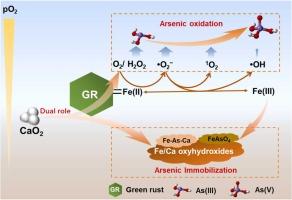Unveiling the dual role of calcium peroxide in enhancing green rust-catalyzed arsenite oxidation and stabilization
IF 12.2
1区 环境科学与生态学
Q1 ENGINEERING, ENVIRONMENTAL
引用次数: 0
Abstract
Iron oxyhydroxide redox processes coupled with reactive oxygen species (ROS) generation play a critical role in the transformation of arsenic (As). However, low ROS generation limits the detoxification and stabilization of As(III). In this study, we propose a novel strategy by integrating Fe(II) rich green rust (GR) with calcium peroxide (CaO2) for the efficient transformation of As(III) under oxic conditions. The results demonstrate that the introduction of CaO2 greatly enhances the oxidation and immobilization of As(III) by GR. Quenching experiments reveal that H2O2, ·O2−, and 1O2 are the primary ROS responsible for the oxidation of As(III). Importantly, CaO2 significantly boosts the production of key ROS in the GR/CaO2 system. Additionally, the introduction of CaO2 facilitates the transformation of both non-specific and specific adsorbed As into non-extractable As, improving the stability of immobilized As. Our findings unveil that CaO2 serves a dual role in promoting GR-catalyzed As(III) oxidation and stabilization by enhancing ROS production and forming iron-arsenic-calcium complexes. Moreover, the application of GR/CaO2 in As-contaminated soil can rapidly reduce the risk of As leaching in different scenarios. Therefore, this study provides a new strategy using CaO2 coupled with iron redox process to enhance oxidation and stabilization of arsenic in water and soil.

求助全文
约1分钟内获得全文
求助全文
来源期刊

Journal of Hazardous Materials
工程技术-工程:环境
CiteScore
25.40
自引率
5.90%
发文量
3059
审稿时长
58 days
期刊介绍:
The Journal of Hazardous Materials serves as a global platform for promoting cutting-edge research in the field of Environmental Science and Engineering. Our publication features a wide range of articles, including full-length research papers, review articles, and perspectives, with the aim of enhancing our understanding of the dangers and risks associated with various materials concerning public health and the environment. It is important to note that the term "environmental contaminants" refers specifically to substances that pose hazardous effects through contamination, while excluding those that do not have such impacts on the environment or human health. Moreover, we emphasize the distinction between wastes and hazardous materials in order to provide further clarity on the scope of the journal. We have a keen interest in exploring specific compounds and microbial agents that have adverse effects on the environment.
 求助内容:
求助内容: 应助结果提醒方式:
应助结果提醒方式:


